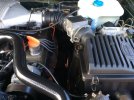Way off track there.
1) the injectors timing is not relevant - they are in fact not "timed" at all and fire in 2 batches based entirely on the spark timing signal to the ECU. When starting it fires both batches together, then moves to alternating firing. The first batch-fired side isn't even the same side, relative to engine timing each start - it's based entirely on the first spark signal the ECU sees and it never knows which cylinder is firing anyway.
2) If it doesn't fire or cough with easy spray, there is NO point in even looking at the fuel system - you either have an ignition or compression issue (more likely ignition, because easy spray should at least make a pop!)
SO, to be clear: you're saying it just cranks and cranks, without any pops, bangs, coughs, nothing - just smooth cranking?
You need to do the basics properly, then move on from there.
Compression test. This could show several issues that could cause no starting.
Check for cranking RPM in Rovergauge while cranking (this shows the spark trigger system and the reading to the ECU working, though doesn't guarantee actual spark).
Check for spark at the coil wire to the distributor, if present THEN to each plug. You can get an in-line spark tester, so you can SEE the spark, while it's firing the plug in the cylinder. If you aren't getting backfires, pops, bangs or coughs, chances are there is no spark in the cylinders - otherwise the easy start would at least cause a noise. You could also use an inductive timing light on lead one and see if the light is triggered... and you could also check the actual timing at the same time if it does.
Personally, I'd pull the fuel pump fuse until after being sure the ignition is working, then try a puff of easy start to see if you get some action. Once I knew the ignition was working, then I'd put the fuse back and try again. It sounds like it's just pumping fuel in, but has no spark to start.
He says he has spark so easy start should give at least a cough my guess is no compression have seen it with snapped camshaft I would pull a rocker cover and see for movement...

